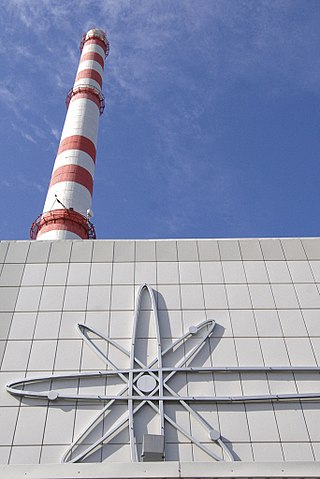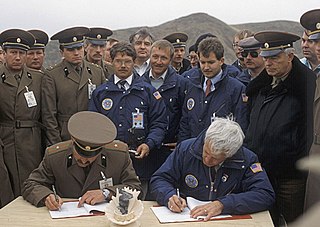
Rosatom, also known as Rosatom State Nuclear Energy Corporation, the State Atomic Energy Corporation Rosatom, or Rosatom State Corporation, is a Russian state corporation headquartered in Moscow that specializes in nuclear energy, nuclear non-energy goods and high-tech products. Established in 2007, the nonprofit organization comprises more than 350 enterprises, including scientific research organizations, a nuclear weapons complex, and the world's only nuclear icebreaker fleet.

Cameco Corporation is the world's largest publicly traded uranium company, based in Saskatoon, Saskatchewan, Canada. In 2015, it was the world's second largest uranium producer, accounting for 18% of world production.
The Megatons to Megawatts Program, also called the United States-Russia Highly Enriched Uranium Purchase Agreement, was an agreement between Russia and the United States whereby Russia converted 500 metric tons of "excess" weapons-grade uranium into 15,000 metric tons of low enriched uranium, which was purchased by the US for use in its commercial nuclear power plants. The official name of the program is the "Agreement between the Government of the Russian Federation and the Government of the United States of America Concerning the Disposition of Highly-Enriched Uranium Extracted from Nuclear Weapons", dated February 18, 1993. Under this Agreement, Russia agreed to supply the United States with low-enriched uranium (LEU) obtained from high-enriched uranium (HEU) found to be in excess of Russian defense purposes. The United States agreed to purchase the low-enriched uranium fuel.

Russia is one of the world's largest producers of nuclear energy. In 2020 total electricity generated in nuclear power plants in Russia was 215.746 TWh, 20.28% of all power generation. The installed gross capacity of Russian nuclear reactors is 29.4 GW in December 2020.

The uranium market, like all commodity markets, has a history of volatility, moving with the standard forces of supply and demand as well as geopolitical pressures. It has also evolved particularities of its own in response to the unique nature and use of uranium.
Vladimir Alexeyevich Smirnov is a prominent Russian businessman, former Director General of the Petersburg Fuel Company (1997–1998), former Chairman of the Board of Directors of the Petersburg Fuel Company (1999–2001). In 2002–2007 he was the Director General of Tekhsnabexport (TENEX) which carries out export of goods and services produced by Russian nuclear enterprises.

Atomenergoprom is a 100% state-owned holding company that unifies the Russian civil nuclear industry. It is a part of the Rosatom State corporation.
Techsnabexport, internationally known as TENEX, is an overseas trading company owned by Russian state-owned company Rosatom. Techsnabexport is an exporter of enriched uranium and a supplier of nuclear fuel cycle products.

National Atomic Company Kazatomprom Joint Stock Company (Kazatomprom) (Kazakh: Қазатомөнеркәсіп, romanized: Qazatomónerkásip) is the world’s largest producer and seller of natural uranium, providing over 40% of global primary uranium supply in 2019 from its operations in Kazakhstan. Kazatomprom's uranium is used for the generation of nuclear power around the world.
Paladin Energy Ltd is a Western Australian based uranium production company.
Energy in Kazakhstan describes energy and electricity production, consumption and import in Kazakhstan and the politics of Kazakhstan related to energy.
The mineral industry of Kazakhstan is one of the most competitive and fastest growing sectors of the country. Kazakhstan ranks second to Russia among the countries of the CIS in its quantity of mineral production. It is endowed with large reserves of a wide range of metallic ores, industrial minerals, and fuels, and its metallurgical sector is a major producer of a large number of metals from domestic and imported raw materials. In 2005, its metal mining sector produced bauxite, chromite, copper, iron, lead, manganese, and zinc ores, and its metallurgical sector produced such metals as beryllium, bismuth, cadmium, copper, ferroalloys, lead, magnesium, rhenium, steel, titanium, and zinc. The country produced significant amounts of other nonferrous and industrial mineral products, such as alumina, arsenic, barite, gold, molybdenum, phosphate rock, and tungsten. The country was a large producer of mineral fuels, including coal, natural gas, oil, and uranium. The country's economy is heavily dependent on the production of minerals. Output from Kazakhstan's mineral and natural resources sector for 2004 accounted for 74.1% of the value of industrial production, of which 43.1% came from the oil and gas condensate extraction. In 2004, the mineral extraction sector accounted for 32% of the GDP, employed 191,000 employees, and accounted for 33.1% of capital investment and 64.5% of direct foreign investment, of which 63.5% was in the oil sector. Kazakhstan's mining industry is estimated at US$29.5 billion by 2017.

Atomredmetzoloto, JSC,, the Mining Division of Rosatom State Atomic Energy Corporation, is a Russian uranium producer internally ranked sixth in the world in terms of uranium production and second in terms of in-situ uranium reserves.
The Honeymoon Mine was Australia's second operating in-situ recovery uranium mine, beginning production in 2011. It is located in South Australia and is 80 kilometres (50 mi) northwest of Broken Hill, New South Wales.

Uranium mining in Kazakhstan is of considerable importance to the national economy. By 2011, Kazakhstan was considered to be the world's largest producer of uranium.
The Willow Creek mine is an in-situ leach (ISL) uranium mining project located in Powder River Basin in the state of Wyoming, United States. It comprises the Irigaray central processing plant and wellfields, and the Christensen Ranch ion exchange plant and wellfields.

The Moiynkum Desert, is a desert in the Turkistan and Zhambyl regions of southern Kazakhstan.
The Uranium One controversy involves various theories promoted by conservative media, politicians, and commentators that characterized the sale of the uranium mining company Uranium One to the Russian state-owned corporation Rosatom as a $145 million bribery scandal involving Hillary Clinton and the Clinton Foundation. No evidence of wrongdoing was ever found.

Orano SA is a multinational nuclear fuel cycle company headquartered in Châtillon, Hauts-de-Seine, France. The company is engaged in uranium mining, conversion-enrichment, spent fuel recycling, nuclear logistics, dismantling, and nuclear cycle engineering activities. It was created in 2017 as a result of restructuring and recapitalizing of the nuclear conglomerate Areva. Orano is majority owned by the French state. As of September 2021, Orano is the second largest uranium producer in the world with 9% share in global uranium production.

The Republic of Kazakhstan, once a republic of the Soviet Union, was a primary venue for Soviet nuclear weapon testing from 1949 until 1989. Following the collapse of the Union of Soviet Socialist Republics (USSR) in 1991, Kazakhstan became the fourth-largest nuclear power in the world and hosted a considerably large weapon support infrastructure due to its reliance on the Soviet nuclear program as a means to develop its own local economy. Besides the nuclear program, Kazakhstan was also a prominent site of Soviet programs of biological and chemical weapons.











